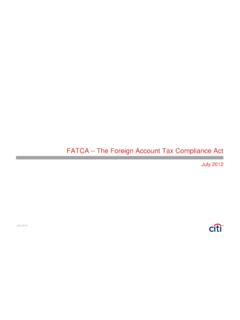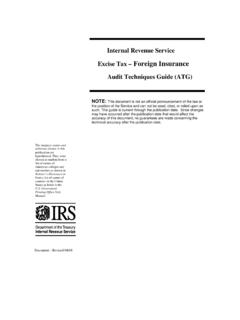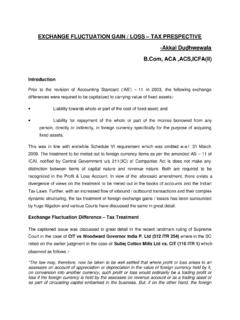Transcription of GK vs. KK A Comparison of Two Popular Japanese …
1 - 1 - GK vs. KK A Comparison of Two Popular Japanese corporate Structures For foreign companies wishing to commence operations and to have personnel on the ground in Japan, a key consideration is the choice of legal form through which to do business. Some foreign groups commence operations through a "representative office." This form is not registered with the Japanese corporate authorities and is effectively nothing more than an employee of the foreign company conducting market research and liaison activities in Japan.
2 The key drawback of this presence in Japan is that its activities are severely limited only to liaison-type functions (non-income generating liaison, support and promotion) performed for home office, and ongoing business by this presence is not permitted. A more substantive business presence is the registered Japan branch, a quasi-legal Japanese entity able to conduct business in Japan and subject to Japanese corporate taxation in its own right. Drawbacks of this form of entity include (a) liability for the Japanese operations flowing directly back to the foreign company without any corporate veil protection at the Japanese level (further, since 2006 a paper group company is effectively no longer permitted to act as a buffer in this regard), (b) the potential for Japan tax audit queries extending beyond Japan, and (c) a lower level of prestige - as contrasted with true Japanese corporate entities - for the entity in doing business in Japan.
3 For the above reasons, foreign companies wishing to have personnel on the ground and living in Japan often prefer to establish a standalone Japanese corporate entity. The main options available in this respect are the "kabushiki kaisha/KK" (joint stock company) and the "godo kaisha/GK" (limited liability company). These entities in turn operate either on a cost-plus or buy-sell basis for Japan purposes; the selection of this itself dependent on the exigencies of the planned business, the required activities of the personnel on the ground, and the business requirements of the business' Japanese customers and partners.
4 KK The joint stock company (KK) is the most typical entity selected by non- Japanese entities when establishing a Japanese corporate subsidiary. The KK is often considered the most attractive option for non- Japanese parent companies, because historically it is perceived to be the most prestigious and stable entity. Due to its reputable nature, the KK is most likely to be respected by potential Japanese partner companies, contractors, customers, and employees. The KK is also the legal form most often selected by investors conducting substantial business in Japan.
5 When considering whether to establish a KK, the potential requirements both at establishment and over the life of the entity may be an important factor depending on the type of presence the foreign group wishes to have in Japan. In terms of statutory requirements, generally speaking a KK must have at least one representative director who is a resident of Japan (this person need not be a Japanese citizen) and it must hold a shareholder meeting at least once a year within three months of the end of each fiscal term. Under certain conditions a KK can operate without a board of directors in what is locally known as a 'one-man' structure , though this is often viewed negatively in the marketplace as the entity may not appear to be sufficiently robust for Japanese partners and/or customers, especially in the case of the KK conducting buy-sell business in Japan.
6 When a KK does elect to have a board of directors, the minimum number of directors is three and the KK must also appoint at least one statutory auditor (a kind of director-supervising officer). The statutory auditor should ideally have accounting knowledge but is not legally required to be an accountant. The KK therefore generally requires a slightly greater commitment in terms of ongoing compliance than may be present with other available entities in Japan. However the benefits of the KK will in many cases outweigh the potential disadvantages, especially given that any of a Japan branch, GK or KK still must file a corporate tax return in any event.
7 The KK is scalable and appropriate for most any business in Japan as it will be acceptable to all customers, partner and potential employees, and can even list on Japanese stock exchanges. With good cooperation from the parent company client a KK may be established within as little as two weeks. - 2 - 2011 GK The limited liability company (GK) has been an available corporate option since 2006 and is more accurately a hybrid between a corporation and a partnership, and unfortunately brings with it all the complexity this implies.
8 The GK is particularly Popular with US parent companies as while the GK is taxed in Japan as a non-pass-through corporation on its income, it may be disregarded for tax purposes as a pass-through (the so-called 'check the box') for US tax purposes. This form of entity effectively replaced in 2006 the YK entity which previously enjoyed this tax status in the US. While GK entities are therefore often preferred by US parent companies for their Japan subsidiary, this is not true for parent companies of other jurisdictions - given the GK entity's partnership-style structure , comparatively complex and cumbersome operational procedures, and arguably less-than-perfect limited liability protection.
9 Unlike the KK in which those who invest are shareholders, investors in a GK become members of the GK. When there are no individual members, an executive manager, responsible for managing the company on the members' behalf, needs to be appointed. The legal duties of GK executive managers are similar to the legal duties of KK directors. A GK is not required to establish a board of directors nor to hold members meetings to manage the company's affairs. This effectively means that the entity can operate with fewer ongoing corporate housekeeping requirements.
10 This, however, is not a major save for clients given the need to maintain accounts and to file a tax return in any event. Each member is legally responsible for managing the affairs of and representing the GK (although there is scope for this role to be narrowed under the company's articles) and each member is considered jointly and severally liable for damages to third parties caused by other members or the Executive Manager. In this respect too a GK resembles a partnership. The more complicated structure and technical requirements for establishing a GK mean that they may be established within as little as three weeks with good cooperation from the client.







